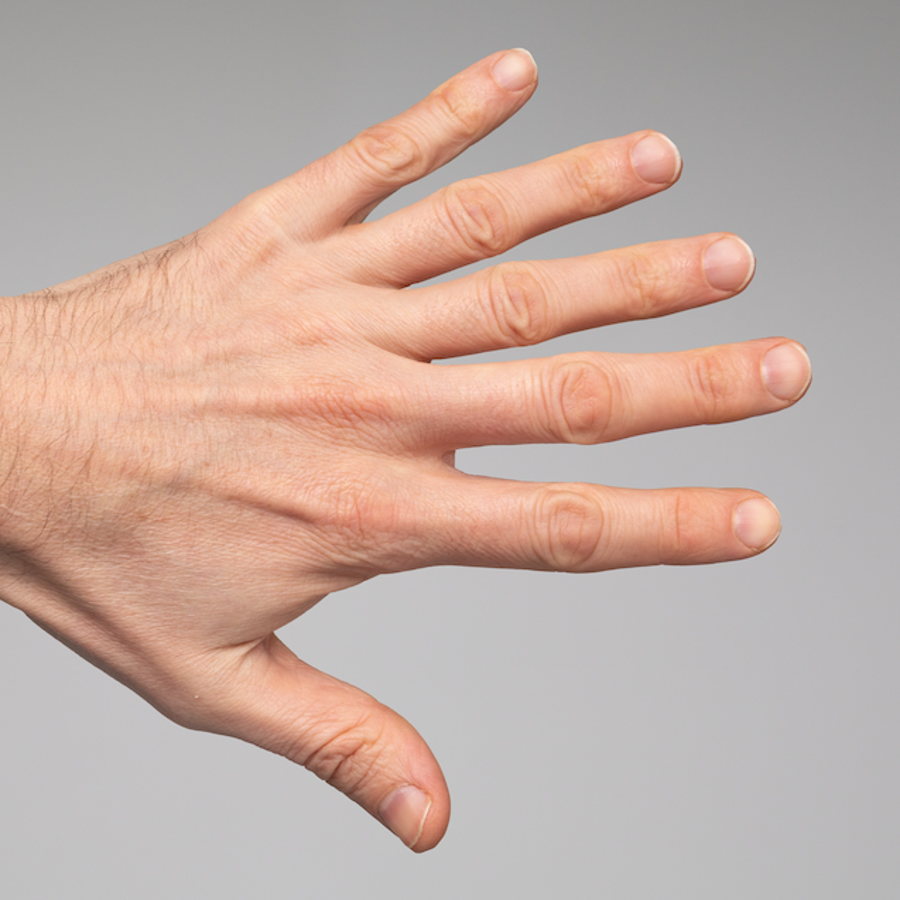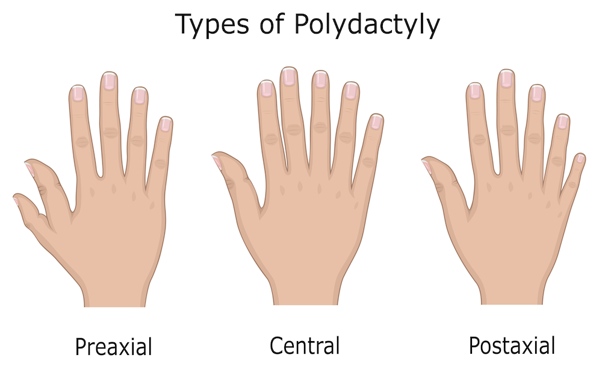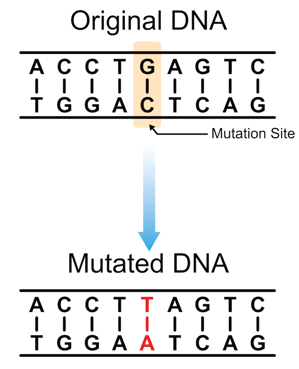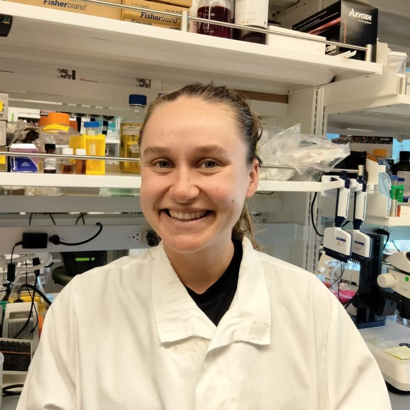
How can polydactyly happen when it’s not inherited?
August 3, 2023

- Related Topics:
- Mutation,
- Developmental biology,
- Autosomal dominant inheritance
"Confused Child" from Pennsylvania asks:
"Both my parents have always had 5 fingers, but my sister has 6. She is the biological daughter of both my parents. I have been taught that 6 fingers is dominant over 5 fingers. Shouldn't at least one of my parents have or have had 6 fingers? How is this possible?"
About 1 in 1000 people are born with an extra finger or toe. This is known as polydactyly. There are over 300 different forms, which fall into three main categories: an extra middle finger, extra thumb, or extra finger on the pinky side.1,2
It’s often inherited as a dominant trait, where someone with polydactyly also has a parent with the trait. However, it can also happen even if neither parent has polydactyly!
There are two other ways that it can happen without being inherited from a parent. First, there could be small changes in your DNA, called mutations, that you don’t inherit from your parents. Secondly, there can be small environmental changes as your hands develop in your mother’s womb. These changes can influence how your body builds your hands, and could lead to polydactyly.

What causes polydactyly?
Your hand begins to form when you are just 34 days old in your mother’s womb. At first, your hands look a bit like a paddle. At this point, your fingers look webbed! Then, your bodies signal where the edges of the fingers are, and the extra tissue between the fingers breaks down.3
There are lots of different, complex signals that work together to tell our body how your fingers should grow. These signals tell your body how many fingers should be made, where they should be and what type of finger. All of these signals are coded by genes in your DNA.
Many genes work together to shape your hand and your fingers. A change in just one of those genes can cause an imbalance of signals as your hand develops. This can result in polydactyly.
Scientists have identified over 16 different genetic causes of polydactyly. For example, some people with polydactyly have genetic differences in GLI3 gene or SHH gene. These are just two of the many genes that work together to shape your fingers and hands. Changes in these genes are implicated in many forms of polydactyly, including having an extra finger on the thumb or pinky side of the hand.1,2
How can polydactyly be inherited?
Because we inherit most of our DNA from our parents, polydactyly is often passed down from our parents.
Sometimes polydactyly happens as a symptom of a larger syndrome. For example, it can appear as part of a more complex genetic condition, such as Trisomy 13 or Meckel Syndrome.
Other times polydactyly is inherited on its own, without any other symptoms. In these cases, it’s often caused by a change in GLI3, SHH, or another gene that controls how many fingers you have. These kinds of polydactyly are usually a dominant trait. If you inherit just one copy of this ‘polydactyly’ gene, then you will have polydactyly.
How can polydactyly arise sporadically?
However, polydactyly can also happen without being inherited from your parents (“sporadic” polydactyly). While it’s hard to pin down exact numbers, it seems like most instances of polydactyly are actually like this! How does this happen?
Your DNA acts as an instruction manual to build your body and hands, but little changes in your DNA can occur as your cells replicate. Most of these new changes (known as mutations) are not harmful, and some can change the way that you look.
The DNA in each of us is made up of 3 billion letters, and around 60 or so of those letters are unique to you and not inherited from your parents.4 If one of those new changes happened in a gene that signals how to shape your hand, you might end up with an extra finger.

One study of 181 sporadic polydactyly patients found that changes in GLI3 were especially common. But GLI3 isn’t the only culprit — the study identified close to 300 genetic differences associated with polydactyly!5
Polydactyly can also occur due to non-genetic reasons. For example, some people have an extra finger on only one hand. Asymmetry like this is often due to things other than genetics (which are more likely to affect both hands). This could be due to small changes in the physical environment in your mother’s womb or any other external factor that even slightly skews the signals that shape your hand.6
Conclusion
Overall, our hand is shaped by signals coded in our DNA. When we inherit DNA from our parents that has a certain mutation, then we will have that too. However, we also have changes in our DNA that are unique to only ourselves! These changes can shape how your hands are built, regardless of our parents.
Additionally, there can be factors outside of genetics that influence the shape of your hands. Small physical changes in your mother’s womb as your hands develop are sufficient to cause polydactyly.
In fact, having an extra finger can be really useful! Some people with an extra finger can complete tasks with one hand that would take 5 fingered people both hands. Human brains are very powerful and can control an extra finger just as well as any other finger.7
Read More:
- Cleveland Clinic: All about polydactyly
- Ask-a-geneticist article from 2012: Is having 5 fingers a dominant trait?
- Cleveland Clinic: How unique changes in our DNA occur
- News Medical Life Sciences: Genetic causes of polydactyly

Author: Angela Pogson
Angela is a PhD candidate in the Department of Developmental Biology, working in Anne Brunet’s lab studying age-related protein aggregation in neural stem cells. She wrote this answer while participating in the Stanford at the Tech program.
 Skip Navigation
Skip Navigation
